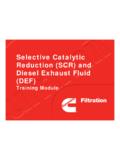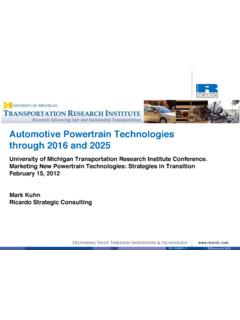Transcription of Global Overview on Vehicle Fuel Economy and …
1 Global Overview on Vehicle fuel Economy and Emission standards Feng An, PhD, Executive Director e gy a d a spo tat o . The Innovation Center for Energy and Transportation e o at o Ce te o iCET . C . presented by Lucia Green Weiskel Expert Group Meeting on Transport for Sustainable Development: Analysis of trends, issues and policy options United Nations Headquarters, New York 27 28 August 2009 1. The Innovation Center for Energy and Transportation (iCET, ). Transportation (iCET, Located in Beijing and Los Angeles, iCET is a China and California registered, non profit, independent, leading policy center in low . carbon development and climate change Low Carbon Transportation Low Carbon Transportation fuel Economy standards for China Green Car Online Rating System Low Carbon fuel standards and Policies Electric Vehicle Research and Promotion Clean Energy and Energy Efficiency Programs Lighting technologies (LED light standards and related policies) US.)
2 US Jiangsu Green Partnership (solar energy). Climate Change Program Energy and Climate Registry (ECR) in China Conferences and Outreach 2. 3. China projects to be the #1 auto market this year, surpassing 11 million unites. Car market exploded in the past decade. Annual growth in new car sales averaged about 24% since 92, trucks 10%, buses 15%. 4. Overview of Countries and Regions that have Vehicle fuel Efficiency y and GHG standards At-least nine countries and regions have established or proposed motor Vehicle fuel efficiency or GHG emission policies. Due to various historic historic, cultural and political reasons, different countries and regions chose to adopt different fuel efficiency or GHG standards . a Country/region Type Measure Structure Test method Implementation Cars and light United States fuel mpg CAFE Mandatory trucks Overall light - European Union CO2 g/km EU NEDC Voluntary duty fleet Japan fuel km/L Weight-based Weight based Japan 10.
3 10-15. 15 Mandatory China fuel L/100-km Weight-based EU NEDC Mandatory Car/LDT1 and California GHG g/mile CAFE Mandatory LDT2. Cars and light Canada fuel L/100-km L/100 km CAFE Voluntary t k trucks Overall light- Australia fuel L/100-km EU NEDC Voluntary duty fleet South Korea fuel km/L Engine size CAFE Mandatory a Test methods include Corporate Average fuel Economy (CAFE), New European Drive Cycle (NEDC), and Japan 10-15 Cycle. See Appendix for more details. 5. Differences in test driving cycles are crucial ftp 80. US Cit City Cycle C l 80 US HWY Cycle C l hwy 70. 70. 60. 60. 50. 50. mph 40. mph 40. 30 30. 20 20. 10 10. 0 0. 0 200 400 600 800 1000 1200 0 100 200 300 400 500 600 700. New European Drive Cycle (NEDC) NEDC. 80 Japan 10-15 Cycle japan 80. 70.
4 70. 60. 60. 50. 50. mph h 40. mph 40. 30. 30. 20. 20. 10 10. 0 0. 0 200 400 600 800 1000 0 100 200 300 400 500 600. 6. Revised Japanese Test Cycle . New JC08 Cycles 7. Structures of fuel Economy /GHG standards Vary Greatly Among Countries/Regions Fleet Average Target: EU (CO2, g/km). Australia (L/100-km). Divided by Vehicle Categories US, US Canada (mpg) - Cars and LDTs LDTs, California (CO2, g/mile) - (PC/LDT1, LDT2). Based on Vehicle /engine attributes: Vehicle Test Weight Bins Japan (km/L) - 9 weight classes China (L/100-km) - 16 weight classes Based on Engine Size South Korea (km/L). Based on Vehicle Footprint Newly Ne l adopted US, US EU standards 8. Test Cycle Conversion Factors y Conversion factors from measures of different countries/regions to CAFE.
5 CAFE-equivalent i l t MPG. MPG, EUEU-equivalent i l t CO2 in i g/km, /k and dCCalifornia- lif i equivalent CO2 emission rate of g/mile Converted to Converted to Converted to Measure CAFE- EU- CA- Country Cycle Type (Y) equivalent equivalent equivalent mpg CO2 (g/km) CO2 (g/mi). United States CAFE fuel mpg Y* 1/(Y) * 6,180 1/(Y) * 8,900. South Korea City fuel km/L Y* 1/(Y) * 2,226 1/(Y) * 3,206. Canada CAFE fuel L/100-km 1/(Y) * Y* Y* California CAFE CO2 g/mi 1/(Y) * 8,900 Y* Y* European Union (gasoline) NEDC CO2 g/km 1/(Y) * 6,180 Y* Y* European Union (diesel) NEDC CO2 g/km 1/(Y) * 7,259 Y* Y* Japan Japan fuel km/L Y* 1/(Y) * 1,946 1/(Y) * 2,803. China, Australia NEDC fuel L/100-km 1/(Y) * Y* Y* 9. 10. 11. 12. 13. 14. California retains independence in making its own GHG standards CARB is working on Pavely 2 Regulations for post- 2016 Likely 60-80+.
6 MPG requirements for Ultra Low Carbon Vehicles (ULCVS). 15. Road Map for 50% GHG reduction by 2050. PHEV/EV and Ultra Low Carbon Fuels are the Keys y H2 and other ULCFs H2 and other ULCFs 16. De-carbonize transportation Our only hope is to Decouple Carbon emissions andd Vehicle V hi l Ownership! O hi ! g/km 2050. 17. Conclusions Worldwide Vehicle sales will continue to grow in the foreseeable future Oil consumption will continue to grow under BAU scenario A series of Global fuel A series of Global fuel efficiency efficiency programs have been undertaken programs have been undertaken However, current actions insufficient to make fundamental reversion of GHG growth, not to mention a 50% GHG reduction target by 2050. target by 2050. Much more aggressive targets and strategies are urgently needed A paradigm shift and transformation to decouple carbon emissions from Vehicle ownership is critical Will PHEVs/EVs and ultra low carbon fuels be our best hope?
7 18.













